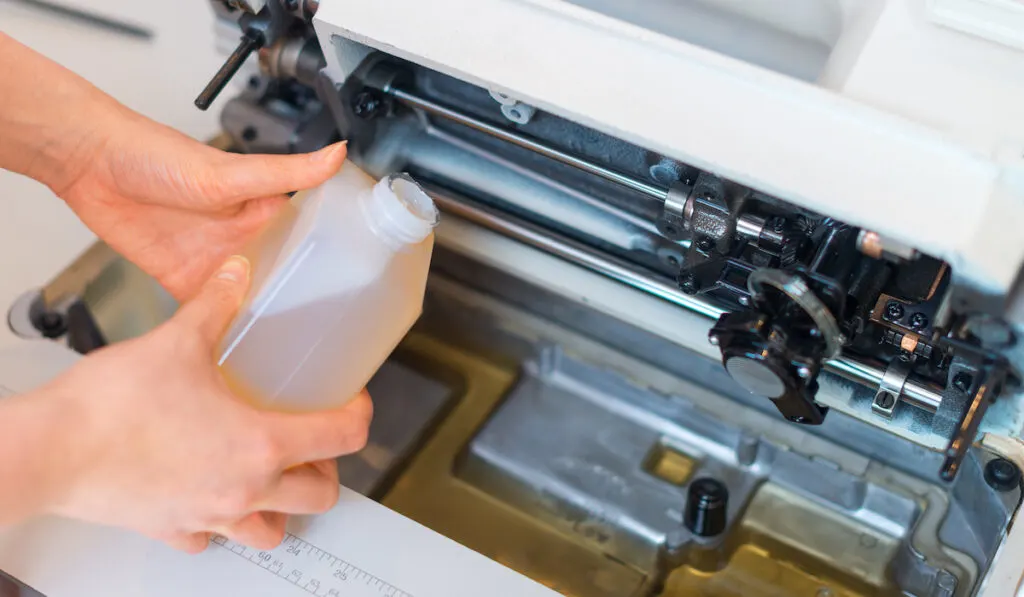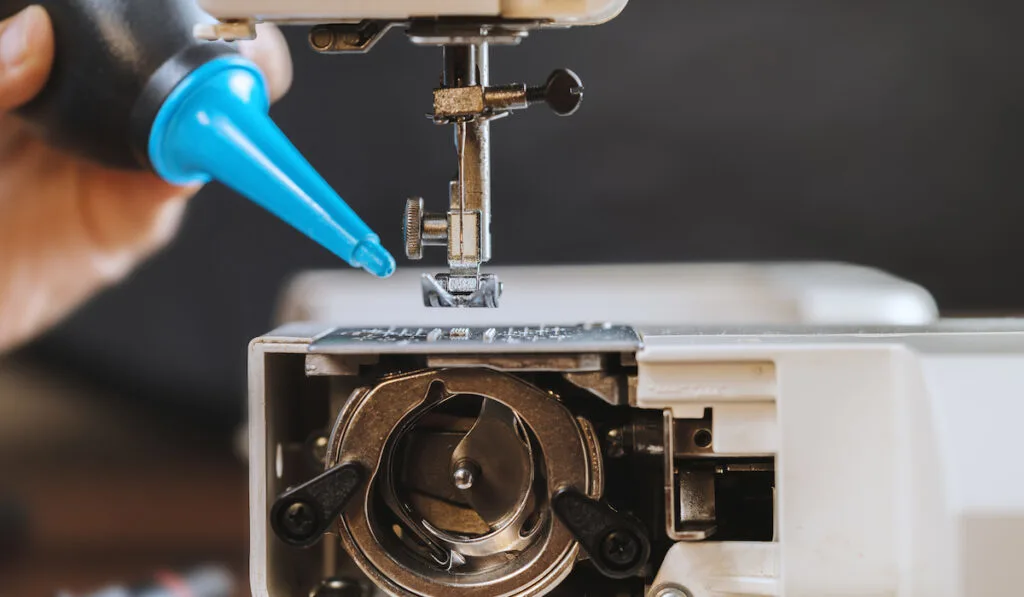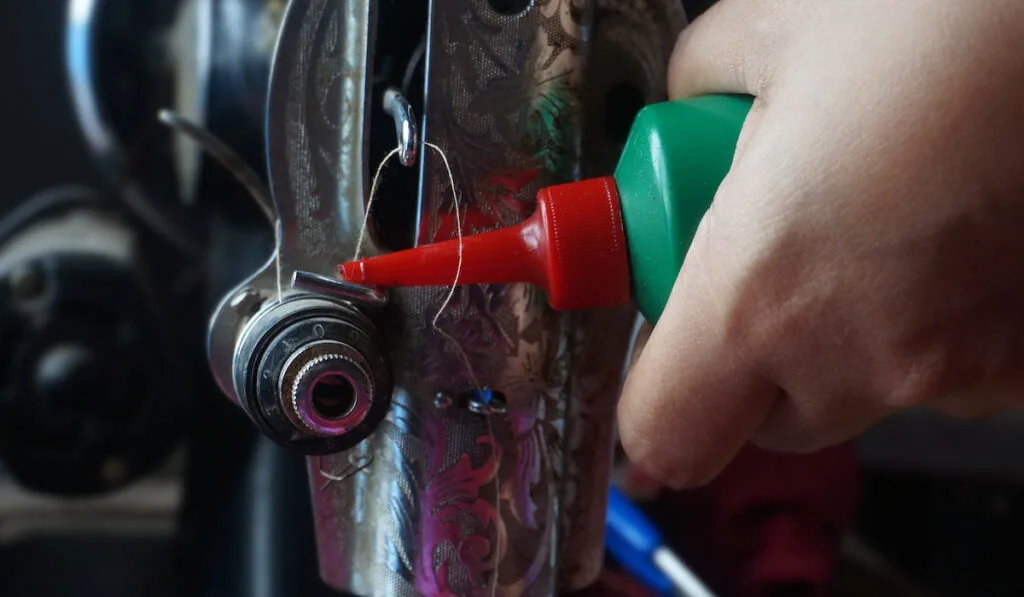A sewing machine is a mechanical device, and like other machines with moving parts, it needs regular lubrication. If you are not lubricating your sewing machine regularly, you are bound to encounter different faults while using it.

So, what should you use to lubricate your sewing machine? Sewing machines are normally lubricated with sewing machine oil.
But if you don’t have any sewing machines oil on hand, what else can you use? The good news is that there are a number of substitutes you can use to lubricate your sewing machine.
What Is Sewing Machine Oil?
Sewing machine oil is a type of mineral oil made specifically for lubricating the moving parts of sewing machines.
This oil is odorless and clear with light viscosity. Due to its light viscosity, sewing machine oil does not form deposits in the machine parts.
While using your sewing machine, machine oil helps reduce friction between mechanical parts. This keeps the moving parts from rubbing against each other directly and reduces the chances of wearing and overheating.
Before you use a sewing machine oil, please check the machine’s manual. Not all sewing machines need lubrication; some lubricate themselves, and those that have nylon or plastic parts need no lubrication.
5 Substitutes for Sewing Machine Oil
If you don’t have any sewing machine oil available and need to lubricate your machine to fix an issue or avoid overheating, you can use the following oils on your machine.
1. Clock Oil
Clock oil is a great substitute for sewing machine oil. In fact, these two of oils can be used interchangeably. Sewing machine oil is used on clocks, and clock oil is used on sewing machines.
The distinction between them is their fluidity. Sewing machine oil flows and spreads, but clock oil usually stays in place. So, you have to be cautious about the quantity of clock oil you use on your sewing machine.
2. Marvel Mystery Oil
Marvel mystery oil was created almost eight decades ago. The creators did not reveal the oil’s formula, so it remains a mystery just as the name says.
The original purpose of marvel mystery oil was to prevent corrosion in carburetors. It is still used in automotive machinery and for lubrication in various types of engines.
Marvel mystery oil is not very thick and can be used on small mechanical appliances including sewing machines.
3. White Mineral Oil
White mineral oil does not live up to it’s name since it isn’t actually white. It is transparent fluid and is also known as liquid petroleum. This oil is commonly available and fairly inexpensive.
White mineral oil is formed as a byproduct in the process of distilling petroleum. Since it has a light consistency, white mineral oil can be applied to sewing machines.
4. Tri-Flow Oil
Tri-flow oil works for many domestic lubrication purposes including sewing machine lubrication. It is made from a combination of Teflon and petroleum products. The addition of Teflon gives it extra slippery properties.
Tri-flow oil is usually more expensive than sewing machine oil. But one advantage of tr-flow oil is its resistance to heat. Even at high temperatures or heat generated by increasing friction, it keeps working well.
5. Clipper Oil
Clipper oil is a great alternative to sewing machine oil. This low-viscosity oil is usually used to lubricate hair trimmers to help the blades last longer.
Both types of oils can be used interchangeably: you can use sewing machine oil for a clipper, and clipper oil for a sewing machine.

Other Considerations for Substitute Lubricants
Is Baby Oil Safe for a Sewing Machine?
Although baby oil may be thin enough to be used as a lubricant in a sewing machine, it might not be ideal.
Besides containing mineral oil, baby oils contain perfume and other additives that may be unfit for your sewing machine. Before using baby oil or other substitutes with additives, try to use another lubricant with more pure composition.
Is Clipper Oil the Same as Sewing Machine Oil?
Clipper oil and sewing machine oil are quite similar. In some cases, clipper oil can be less viscous.
Clippers run at high speeds, so clipper oils should do well even with the most powerful sewing machines.
Is Gun Oil the Same as Sewing Machine Oil?
Gun oil and sewing machine oil are not the same. They are both mineral oils and have the same viscosity, but they may not always find the same applications since gun oil is not compatible with plastic.
Many sewing machines have plastic parts, so using gun oil on such machines will damage those parts. If your sewing machine does not have plastic parts, then you can apply small amounts of gun oil as a lubricant.
Oils You Shouldn’t Use With Your Sewing Machine
If you need an alternative lubricant for your sewing machine, steer clear of the following:
- Cooking oil such as olive oil or vegetable oil
- Paraffin
- Butter
- Lard
- Kerosene
- Gasoline
- WD-40
- 3-in-1 oil
- Cooking spray
- Grease
- Automotive oil
How to Oil a Sewing Machine
The procedure for oiling a sewing machine differs across brands. For a specific guide on how to oil your sewing machine, check the manual. If your manual does not include instructions or indicate the areas you should oil, the manufacturer may prefer that you take your sewing machine to a professional for maintenance.
The following is a general guide to oiling your sewing machine:
- Switch off the machine and unplug it.
- Remove the thread, the presser foot, and other parts of the machine that will get in the way of cleaning.
- Get a brush and use it to clean dust and other residues from the machine.
- Clean the bobbin area, the bobbin case, and every other part of the machine containing lint.
- You may also clean the machine with compressed air. Hold the can at an angle, and keep it at least 5 inches away to avoid blowing the lint deeper into the machine.
- After cleaning, you may then oil the machine. Check the manual to know which part of the machine needs oil. Only use a few drops of oil on each part, and wipe off the excess.
Where Should I Oil My Sewing Machine?
In many cases, the manual indicates the parts of the sewing machine you should oil. But generally, these are the parts commonly oiled:
- The shuttle hook
- The bobbin area
- The cylinder
How Often Should I Oil My Machine?
Generally, the frequency of the lubrication of your machine depends on how often you use it, and the kind of fabric you sew.

You should oil your sewing machine every week if you use it every day.
If you sew less than 15 times in a month, oil the machine monthly. But if you sew less than 5 times a month, you may oil the machine every 3-4 months.
If you keep tabs of how long you spend using the machine, oil it after every 8 hours of sewing. You may also choose to lubricate it after every sewing project.
Whenever you sew heavy fabric, you should oil the machine at least twice as often than the recommendations above. When oiling, be sure not to use too much oil.
Signs Your Machine Needs to Be Oiled
When your machine shows the following signs, it may need oil:
- Slower sewing speed
- Overheating in any mechanical part
- Burnt smell
- Unusual sounds while working
- Poorly aligned seams
Final Thoughts
The best lubricant for sewing machines is sewing machine oil. You should only opt for substitutes when you have no other options or there is an urgent need to add lubrication. Before you attempt to oil your machine, confirm what the manufacturer advises in the manual.
Resources
- https://sewingmachineclub.com/sewing-machine-oil-substitute/
- https://www.hunker.com/12306333/sewing-machine-oil-alternatives
- https://www.allfreesewing.com/Reference-Information/What-is-Sewing-Machine-Oil
- https://mb.nawcc.org/threads/sewing-machine-oil
- http://shesasewingmachinemechanic.blogspot.com/2013/04/the-wrong-oil.html
- https://www.makersnook.com/sewing-machine-oil-substitutes/
- https://www.wikihow.com/Oil-a-Sewing-Machine
